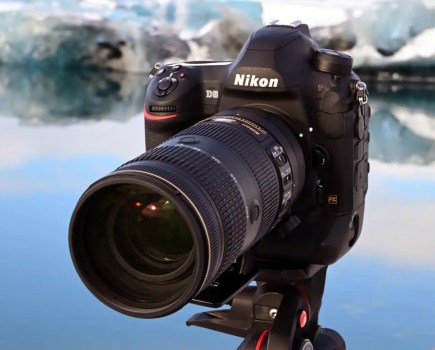The Amateur Photographer Awards is the UK’s premier awards event for the photographic trade. Now in its 43rd year, the most important figures in the industry gathered at our glittering event in London last week as we revealed our favourite cameras and kit tested during the previous year.
As a weekly, AP tests more cameras, lenses and accessories than any other UK magazine and our ruthlessly independent testing team has an industry-wide reputation for the most in-depth and scientific kit reviews in print. So an award from AP’s testers really means something. While you can argue that few really bad cameras or lenses are released these days, not every camera is right for every user. Our tests help identify who a product might best suit. So read on to discover our top gear of the past 12 months. And why buy something good when you can get something great for the same money?
Accessory of the Year: Datacolor SpyderX

Why we like it
- Super-fast profiling
- Reliable and accurate results
- Straightforward, easy-to-use software
Colour management can be something of a minefield for photographers. The crucial first step to getting the colours right in your photos is monitor profiling, and Datacolor has made this quicker and easier than ever with the SpyderX. With a completely redesigned spectrophotometer housed within its sleek white plastic shell, it’s capable of completing the process in two minutes flat. Successive calibration checks to ensure continued colour accuracy can take as little as 30 seconds.
Datacolor’s software guides you step-by-step through the process, showing useful context-sensitive help on the right-hand side of the window when you hover your mouse over any of the various options. It’s a model of clarity, and goes about as far as realistically possible to ensure that you don’t overlook any detail.
Four different kits are available, with the most affordable SpyderX Pro option (£159) being ideal for photographers who just want to calibrate their screens, and get their laptop and desktop monitors to match each other. For £399, the Studio kit adds the ability to create paper profiles for more reliable colour printing at home. If you’ve ever struggled getting colours to look right onscreen and in print, this is a fine solution.
Accessory of the Year: Fujifilm instax mini Link
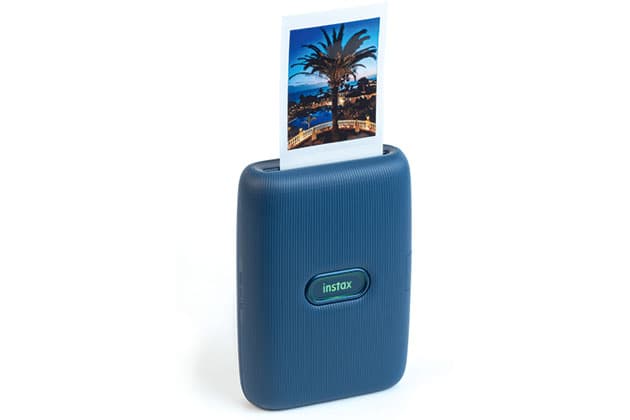
Why we like it
- Easy to use
- Excellent print quality
- Simple, reliable Bluetooth connection
While we now predominantly view our images on phone or computer screens, nothing matches real, physical prints. Producing large prints for display can be very satisfying, but there’s also a lot to be said for making small prints to carry in your wallet or give away. This is where Fujifilm’s instax mini Link excels.
This smart little device is powered by a built-in rechargeable battery and connects to your smartphone or tablet via Bluetooth. Compared to the firm’s older Wi-Fi based models, this makes it both less power-hungry and simpler to use. There’s just a single external control, in the shape of a large power button. Simply turn the printer on and it’ll connect to your phone and be ready to go. The sleek, curvy, attractive design is available in a choice of three colours, and at 12.5x9x3.5cm and 209g in weight, it’ll slip easily into a coat pocket or bag.
Everything is controlled through a dedicated free app for Android or iOS devices. It’s attractively designed and offers a good range of functions that are all made intuitive and accessible. Most importantly, the device consistently delivers gorgeous little prints with fine detail and vivid colour.
Accessory of the Year: Vanguard VEO Select 49

Why we like it
- Converts easily between shoulder bag and backpack
- Choice of top or side access
- High-quality construction
- Carry-on compatible
We’ve seen a lot of camera bags over the past year that aim to combine the carrying comfort of a backpack with the convenient access of a shoulder bag, with varying degrees of success. But we were most impressed by Vanguard’s VEO Select 49, an incognito backpack that lets you easily tuck away the harness and attach a shoulder strap for use as a messenger bag instead.
Its spacious interior provides room for a DSLR or mirrorless camera with a 70-200mm f/2.8 lens attached, plus two to three lenses, a flash and accessories. It comes configured as a daypack, with the top third being a handy place to store clothes when travelling with just hand luggage. Alternatively the dividers can be rearranged to free up this space for a large lens such as a 150-600mm telezoom. Meanwhile those who want to work or edit on the go will be grateful for the 15in laptop sleeve.
If you pack sensibly you can cram a surprising amount of kit inside, and it’s comfortable to carry in both backpack and shoulder bag configurations. When you consider its versatility and how well it’s made and put together, it offers sensational value for money. It’s by far the best hybrid bag we’ve tested.
Nominees
- Billingham Hadley Pro 2020
- Datacolor SpyderX
- Fujifilm instax mini Link
- Manfrotto BeFree GT XPRO Carbon
- Rode Wireless GO
- Vallerret Markhof Pro 2.0
- Vanguard VEO Select 49
Innovation of the Year: Fujifilm GFX100
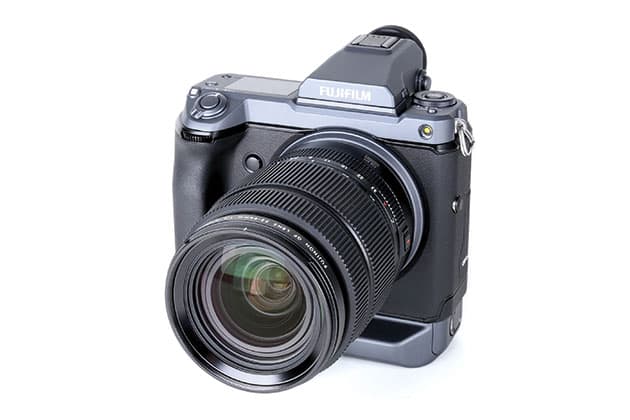
Why we like it
- Absolutely superb image quality in both raw and JPEG
- In-body stabilisation allows practical handheld shooting
- Superb viewfinder and screen
- Excellent build quality
- Works with superlative GF lenses
This award recognises a product or technology that brings something new to the photographic market. With the GFX100, Fujifilm has made the world’s first truly practical super-high resolution camera that can be readily taken out of the studio and used handheld. To achieve this impressive feat, Fujifilm has combined a series of key technologies that have never previously been used together in a medium-format camera.
Firstly, it’s employed a 102-million-pixel back-illuminated sensor measuring 44x33mm, giving 11648 x 8736 pixel image files that can be printed a metre wide at a critically sharp output resolution of 300 pixels per inch. The sensor also features on-chip phase detection, allowing fast and accurate autofocus across almost the entire image area. It’s mounted onto a 5-axis in-body image stabilisation system rated to provide up to 5.5 stops of shake reduction, allowing the camera to be used with confidence handheld. Finally the shutter mechanism is isolated from the camera body to minimise any chance of image blurring from mechanical shock, and automatically selects the appropriate mode to minimise vibration.
All this technology is housed in a robust body that’s no bigger than a professional DSLR. For photographers who need to shoot in the wild without compromising on image quality, there’s really nothing else quite like it.
Nominees
- Epson FastFoto FF-680W
- Fujifilm GFX100
- Nikon AF-S Nikkor 500mm f/5.6E PF ED VR
Wideangle Prime Lens of the Year: Sigma 28mm F1.4 DGHSM | Art
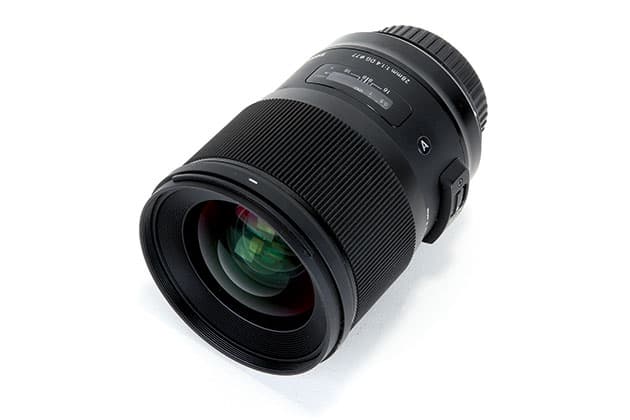
Why we like it
- Robust build quality
- Rapid, quiet autofocus
- High-quality optics
- Full-time manual focus
- Available in a wide range of DSLR and mirrorless mounts
The latest in Sigma’s series of Art primes offers a classic focal length that street, travel, wedding and reportage photographers love to use. It combines all of the features that we’ve come to expect in this highly regarded range, with a large aperture, robust build, and fine optics. It’s available in Canon, Nikon and Sigma DSLR mounts, along with Sony E and Leica L mounts for full-frame mirrorless cameras.
Sigma’s Hyper Sonic Motor performs autofocus duties, giving quiet, decisive AF and supporting full-time manual override. The aperture diaphragm employs nine curved blades to create attractive blur in the out-of-focus areas. Photographers who find themselves shooting in wet or damp conditions will be pleased with its dust- and splash-proof construction. A water-and-oil-repellent coating is applied to the front and rear elements too.
Most importantly, this lens gives attractive images that will stand apart from those taken with a zoom when you want to isolate the subject from the background. Nail the focus at f/1.4 and you’ll get really satisfying results.
Nominees
- Fujifilm XF 16mm F2.8 R WR
- Sigma 28mm F1.4 DGHSM|Art
- Sony FE 35mm F1.8
Standard Prime Lens of the Year: Zeiss Batis 2/40 CF
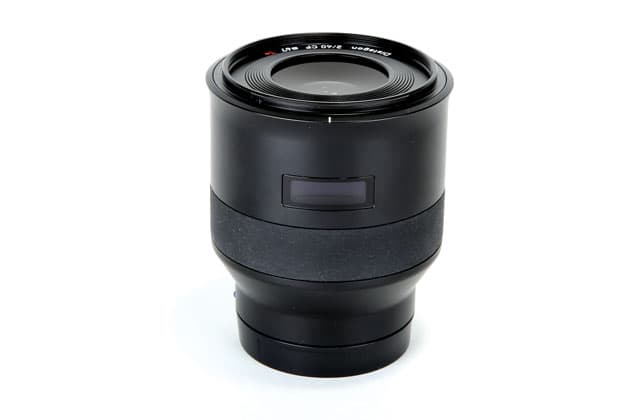
Why we like it
- Superlative image quality
- Fast, decisive AF
- Handy close-focus facility
- Robust, weather-sealed build
- Useful OLED distance scale
Quite simply, the Zeiss Batis 40mm f/2 CF is a wonderful standard lens for Sony full-frame mirrorless users. The image quality it delivers is about as close to flawless as you could hope, with superb detail rendition and minimal aberrations. It offers a handy close-up shooting ability that gives one-third life-size magnification, although it’s not a substitute for a true macro lens. Build quality is superb, autofocus is quick, silent and accurate, and its OLED distance and depth-of-field display is a bonus for manual-focus shooting. There’s a whole lot to like here, and barely anything to complain about.
For many, the unfamiliar-looking focal length may be a barrier to considering this lens, but really it shouldn’t be. In fact there’s a hard core of photographers who’ll swear that this is the ideal standard focal length on full-frame, bringing an extremely natural perspective to your images.
The £1,149 price tag is a more understandable sticking point, but if you’ve bought into a high-end full-frame mirrorless system, it makes sense to invest in top-notch lenses that’ll realise its full potential. Few will deliver better results than the Batis 40mm f/2.
Nominees
- Samyang AF 45mm F1.8 FE
- Sigma 40mm F1.4 DG HSM | Art
- Zeiss Batis 2/40 CF
Telephoto Prime Lens of the Year: Sigma 56mm F1.4 DC DN | Contemporary
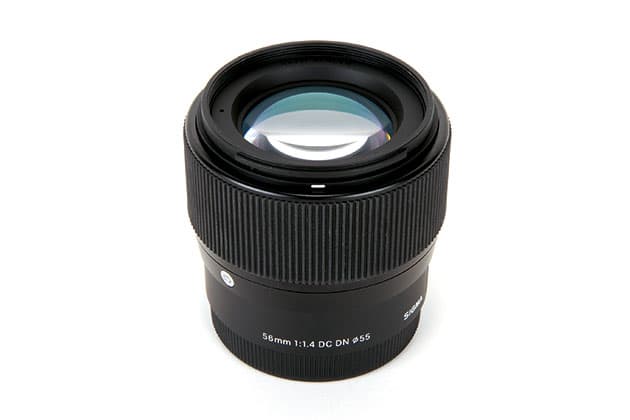
Why we like it
- Fine optics
- Rapid, quiet autofocus
- Compact size
- Robust build
- Very competitive price
Usually, it’s the large, expensive lenses that end up winning awards, as they have the sharpest, best-corrected optics. But in this category, we chose a different option. Sigma’s 56mm F1.4 DC DN is a lovely short-telephoto portrait prime for APS-C and Micro Four Thirds mirrorless cameras, but a price tag of just £349 gives it real mass-market appeal.
Relatively small and light for a f/1.4 prime, the lens provides an 85mm equivalent view on Canon EF-M and Sony E-mount cameras with APS-C sensors, while Micro Four Thirds users benefit from a slightly longer 112mm view. Despite its affordable price, it includes one SLD glass element and two aspherical elements in its 10-element, 6-group design. A nine-blade diaphragm provides a circular aperture for attractive bokeh, while the autofocus stepper motor goes about its business quickly and quietly.
Shooting wide open delivers satisfying results, with sharply defined subjects standing out against smooth blurred backgrounds. The aesthetic of out-of-focus highlights is pleasing too, and there’s just a little vignetting that’s often complimentary to the subject. Indeed for the size and price, you really can’t argue with the lens’s overall performance. It’s a fine compact prime that should attract the attention of many mirrorless users.
Nominees
- Nikon Nikkor Z 85mm F1.8 S
- Sigma 56mm F1.4 DC DN | Contemporary
- Sony FE 135mm F1.8 GM
Wideangle Zoom Lens of the Year: Tamron 17-28mm F2.8 Di III RXD
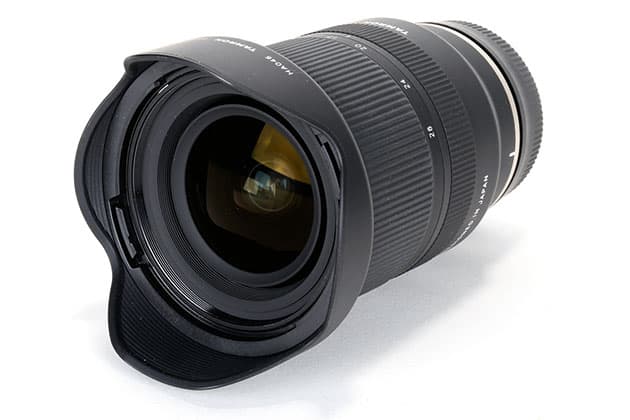
Why we like it
- Impressively sharp, even wide open
- Large maximum aperture
- Compact size and light weight
- Weather-sealed construction
- Super-fast and silent autofocus
Surely the smallest and lightest f/2.8 full-frame wideangle zoom on the market, this fine lens achieves its compact size by employing a relatively modest focal-length range. It features moisture-resistant construction for shooting outdoors in challenging conditions, with fluorine coating on the front element to repel raindrops and fingerprints alike. Autofocus works well for both stills and video shooting, being super-fast and essentially silent.
Where the lens really excels though, is with regard to image quality. This kind of ultra-wide zoom is liable to be used for subjects such as landscapes and architecture, so needs to deliver high resolution right across the frame, low distortion, and strong resistance to flare. Thankfully it scores strongly on all these counts, outperforming most DSLR equivalents. It describes excellent levels of detail even at f/2.8, and stopped down to f/8 to f/16 it produces images that are super-sharp from corner to corner, with 18-point sun-stars thanks to the 9-blade aperture diaphragm.
Overall, this is a very likeable lens that combines impressive sharpness with a fast maximum aperture in a compact, lightweight design. It really hits a sweet spot for Sony full-frame mirrorless users.
Nominees
- Nikon Nikkor Z 14-30mm F4 S
- Tamron 17-28mm F2.8 Di III RXD
- Tokina opera 16-28mm F2.8 FF
Standard Zoom Lens of the Year: Nikon Nikkor Z 24-70mm F2.8 S
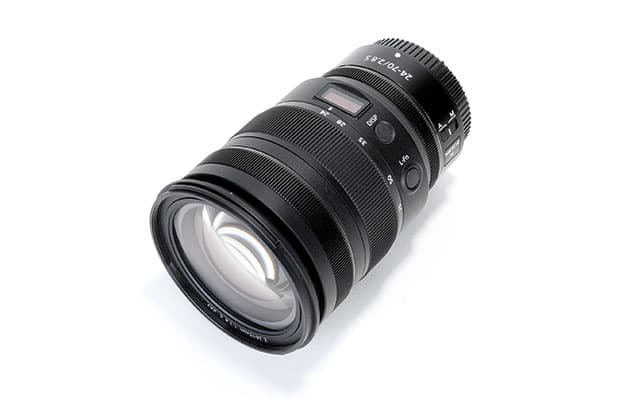
Why we like it
- Stunningly sharp optics
- Pro-level weather-sealed build
- Rapid, silent autofocus
- Useful customisable control ring
- Handy information display
Nikon’s premium standard zoom for its full-frame mirrorless cameras is a top-quality professional workhorse. It takes advantage of the Z mount to reduce size and weight without compromising optical quality, being 25% lighter and 18% shorter than Nikon’s equivalent for F-mount DSLRs.
The build and overall finish is deserving of the demanding photographers that it’s designed for, with extensive weather sealing. A control ring positioned close to the camera body allows adjustment of the aperture, exposure compensation or ISO, while a display panel on top of the barrel toggles through focal length, aperture and focus distance.
Just as we’d expect from a pro-spec lens, the Z 24-70mm f/2.8 S employs advanced optics to meet the demands of high-resolution sensors. It puts in a mighty fine performance, with truly excellent levels of detail delivered between f/5.6 and f/8 at all focal lengths.
Adopt the Z 24-70mm f/2.8 S and you’ll reap the reward of the size and weight advantages it offers. It’s a lens that produces excellent sharpness, is built to the demands of professional use and balances beautifully on full-frame Z-series cameras. It’s not cheap, but it’s the best Z-mount zoom we’ve tested so far.
Nominees
- Nikon Nikkor Z 24-70mm F2.8 S
- Olympus 12-200mm f/3.5-6.3
Telephoto Zoom Lens of the Year: Canon RF 70-200mm F2.8L IS USM
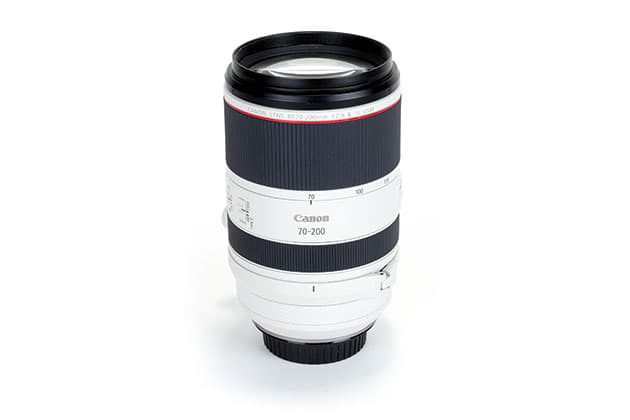
Why we like it
- Compact design
- Incredibly sharp optics
- Effective stabilisation
- Fast, smooth focusing for both stills and video
- Dust and water-resistant construction
The advent of full-frame mirrorless has allowed manufacturers to rethink all aspects of camera and lens design, and this superb fast telezoom is a great example. By using an extending barrel design, Canon has made it considerably smaller and lighter than other 70-200mm f/2.8 lenses, without any concessions in terms build quality or optics.
In keeping with the distinctive look of many Canon professional L-series EF lenses, this is the first RF lens to be given a white heat-shield coating to help keep the optics cool in hot temperatures. Canon has incorporated an electronic floating focus-control mechanism with dual nano ultrasonic motors, making focusing smoother and quieter for stills and video shooting. The latest optical image stabilisation does a fantastic job of combating blur from camera shake.
Optically this lens is a seriously impressive performer, delivering the kind of image quality you’d expect from an L-series lens that sets you back a pretty penny. The results from our tests are very impressive indeed, with quite astonishing sharpness right across the frame from corner to corner. Overall Canon has good reason to be proud of this large-aperture, high-performance RF lens. It’s a quite brilliant telezoom!
Nominees
- Canon RF 70-200mm F2.8L IS USM
- Sigma 70-200mm F2.8 DG OS HSM | Sports
Compact Camera of the Year: Sony RX100 VII
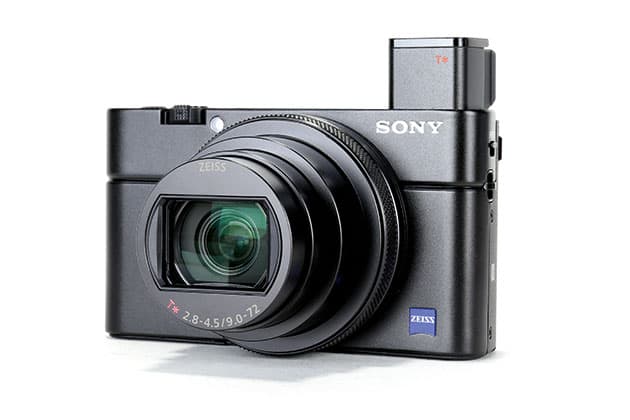
Why we like it
- Impressive lens gives sharp images
- Really useful 24-200mm equivalent range
- Reliable exposure and auto white balance
- Sophisticated autofocus and rapid shooting
- Pop-up viewfinder and tilting screen
With the latest model in its RX100 series, Sony has done what it does best, and crammed an astonishing amount of technology into a tiny package. Somehow it’s fitted a 24-200mm equivalent zoom, pop-up electronic viewfinder, tilting screen, 20fps shooting and 4K video recording into a body that you can slip into a jacket pocket. Compared to the previous model it adds AI-based subject-tracking autofocus that’s unmatched by any of its competitors, and is especially useful if you regularly shoot erratically moving subjects such as sports or children.
If there’s a flaw, it’s that Sony has struggled to make all of these sophisticated features accessible and easy to use. This is a camera you need to spend a bit of time understanding, tweaking and setting up, and then using essentially as a point-and-shoot. But its automated systems are so reliable that you rarely have to intervene manually to get high-quality pictures.
While many will understandably balk at the street price of £1,049, this is, without a doubt, the most technically accomplished compact camera on the market. It’s a fantastic pocket-friendly travel companion for those occasions when you don’t want to carry a DSLR.
Nominees
- Canon PowerShot G5 X Mark II
- Panasonic Lumix FZ1000 II
- Ricoh GR III
- Sony RX100 VII
Smartphone Camera of the Year: Samsung Galaxy Note10+

Why we like it
- Verstatile three-lens camera system
- Well-featured, easy-to-use camera app
- Fantastic image quality
- Useful remote control via stylus
Competition between smartphones to boast the best camera tech has intensified in recent years, with high-end models boasting multiple camera modules, full manual control, and DNG raw recording. You’ll find all of these in Samsung’s top-of-the-range Note10+.
Three camera modules are on board, with an ultra-wideangle 13mm equivalent f/2.2 lens, a telephoto 52mm f/2.1 lens, plus a standard 26mm lens with a variable f/1.5-2.4 aperture. There’s also a fourth DepthVision camera, which is used for creating shallow depth of field effects.
The native camera app offers a wealth of different shooting options, including a straightforward Photo mode that works as a point-and-shoot, a Night mode for low-light shooting, and a well-featured Pro mode. Unusually the Note10+ comes with a stylus that can be used as a remote release – ideal for shooting long exposures, selfies or group shots.
Crucially, image quality is fantastic, with a good degree of uniformity between images captured on the three different lenses. Detail is also good, with nicely saturated colours. Photographers who want their phone to double up as a high-quality pocket camera need look no further.
Nominees
- Apple iPhone 11 Pro
- Google Pixel 4
- Huawei P30 Pro
- Samsung Galaxy Note10+
Consumer Camera of the Year: Canon EOS 250D

Why we like it
- Excellent image quality
- Generously featured
- Small and lightweight
- Capable of 4K video capture
- Fully articulated touchscreen
The most advanced model of Canon’s trio of entry-level DSLRs, and one of the smallest DSLRs on the market, the EOD 250D places technology borrowed from the mirrorless EOS M50 into a compact yet well-featured body. As a result it strikes a great balance between usability and portability, both when shooting stills through the viewfinder and 4K video using the articulated LCD.
Indeed this generously featured, easy-to-use entry-level model has a lot going for it. It’s equipped with a range of novice-friendly features including its built-in Guided Mode and Creative Filters, and there’s plenty for more advanced photography too. It’s capable of shooting at five frames per second, while Canon’s Dual Pixel CMOS sensor provides excellent AF performance and subject tracking when used in live view.
Overall image quality is very good, delivering vibrant colours and enough fine detail to make large prints. A generous set of in-camera processing tools allow you to edit your images without the need for a computer, while built-in Bluetooth and Wi-Fi connectivity allows them to be easily transferred to your smartphone for easy sharing. The result is a really well rounded overall package that’s great for those just getting started in photography.
Nominees
- Canon EOS 250D
- Nikon D3500
Enthusiast Camera of the Year: Fujifilm X-T30
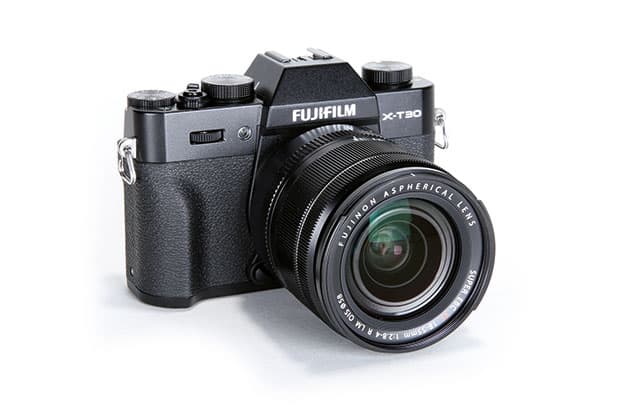
Why we like it
- Intuitive analogue controls
- AF control joystick
- Sophisticated autofocus
- In-camera USB-C battery charging
- Superb JPEG colour output
Fujifilm’s so-called ‘little giant’ is a smaller, lighter and more affordable alternative to the fabulous X-T3. It employs the same 26.1MP X-Trans CMOS 4 sensor, includes a sophisticated 425-point autofocus system with reliable face and eye detection, and is capable of shooting as fast as 30 frames per second. For those interested in video, 4K recording is on offer at up to 30fps.
Despite its diminutive size, the X-T30 handles exceptionally well. Its intuitive user interface is based around traditional analogue dials, with the welcome addition of a joystick controller for fast and intuitive repositioning of the autofocus point.
Image quality is superb in both raw and JPEG, aided by Fujifilm’s peerless Film Simulation modes, which allow you to apply a wide range of attractive colour and monochrome looks to your pictures.
All things considered, the X-T30 is a marvellous mirrorless camera. It provides an excellent spec and performance, while preserving the charm and charisma of the X-series. It’s highly versatile, proving itself to be just as capable shooting static subjects such as landscapes as it is portraiture and high-speed action, sport or wildlife. Its petite size means it takes up very little space in a camera bag. Those who do choose it will fall in love instantly and won’t want to stop using it.
Nominees
- Fujifilm X-T30
- NikonZ50
- Panasonic Lumix G90
Premium Camera of the Year: Olympus OM-D E-M5 Mark III

Why we like it
- Small size and lightweight
- Well-designed control layout
- Incredibly effective in-body stabilisation
- Comprehensive weather-sealing
- Excellent JPEG output
With the third generation of its E-M5 range, Olympus has once again proved that highly specified and capable cameras don’t have to be large and heavy, or use a full-frame sensor. Instead it’s taken full advantage of the Micro Four Thirds format to produce a small, fully featured and weather-sealed mirrorless camera that’s both enjoyable to use, and capable of great results.
This latest model retains the core characteristics that have made the E-M5 range so appealing. Its petite body finds space for an extensive complement of external controls, along with Olympus’s class-leading 5-axis in-body image stabilisation, yet weighs in at a featherweight 414g. Its 20MP sensor includes on-chip phase detection for fast, decisive autofocus. The result is an extremely likeable little camera with a rare combination of portability and ruggedness.
Of course, this doesn’t come for free, and the smaller sensor inevitably means increased noise at high ISOs compared to its peers. But in return, you get access to arguably the best range of small, high-quality lenses for any camera system, plenty of which are weather-sealed. If you like the sound of a camera that’s small, handles well and gives attractive images, and value usability above staring at pixels onscreen, it’s a great choice.
Nominees
- Canon EOS 90D
- Olympus OM-D E-M5 Mark III
- Sony Alpha 6600
Professional Camera of the Year and Product of the Year: Sony Alpha 7R IV
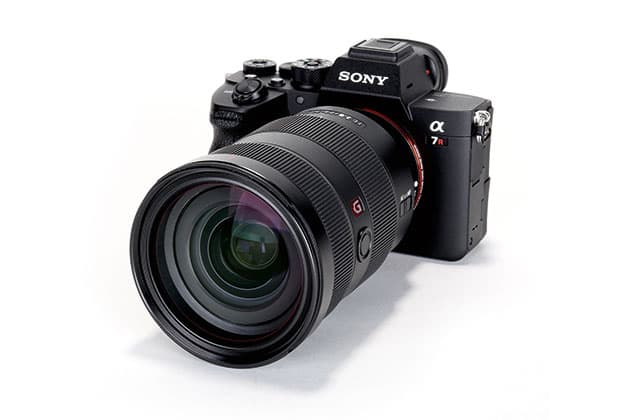
Why we like it
- Mind-blowing detail resolution
- Incredibly fast and responsive AF
- Superb viewfinder
- Highly refined design
- Effective in-body stabilisation
Sony’s Alpha 7R IV is the new master of resolution in the full-frame market. Indeed by developing the world’s first 61MP full-frame sensor, the firm has taken image quality to new heights, without compromising on speed or dynamic range. As a result, it’s made a camera that’s equally accomplished when shooting sport, action or wildlife as it is for landscape or portrait work, which hasn’t usually been the case with high-resolution models in the past.
Sony has also made over 50 improvements compared to its already outstanding predecessor, in response to feedback from its users. These include a larger handgrip, improved weather seals and subtle changes to buttons and dials that further improve the camera’s handling. Other highlights include an excellent electronic viewfinder and effective in-body stabilisation. For those who regularly shoot portraits or fast-moving action, Sony’s industry-leading AI-based Real Time Eye AF and Real-Time Tracking is a revelation, delivering sharp results shot after shot, no matter how the subject moves around the frame.
Overall the Alpha 7R IV is an incredibly powerful mirrorless camera that crams a huge amount into its relatively compact body. Without doubt it’s the best all-rounder you can currently buy. Serious enthusiasts, professionals and commercial photographers after super high-resolution images will surely be tempted by its remarkable abilities.
Nominees
- Fujifilm GFX100
- Panasonic Lumix S1R
- Sony Alpha 7R IV






